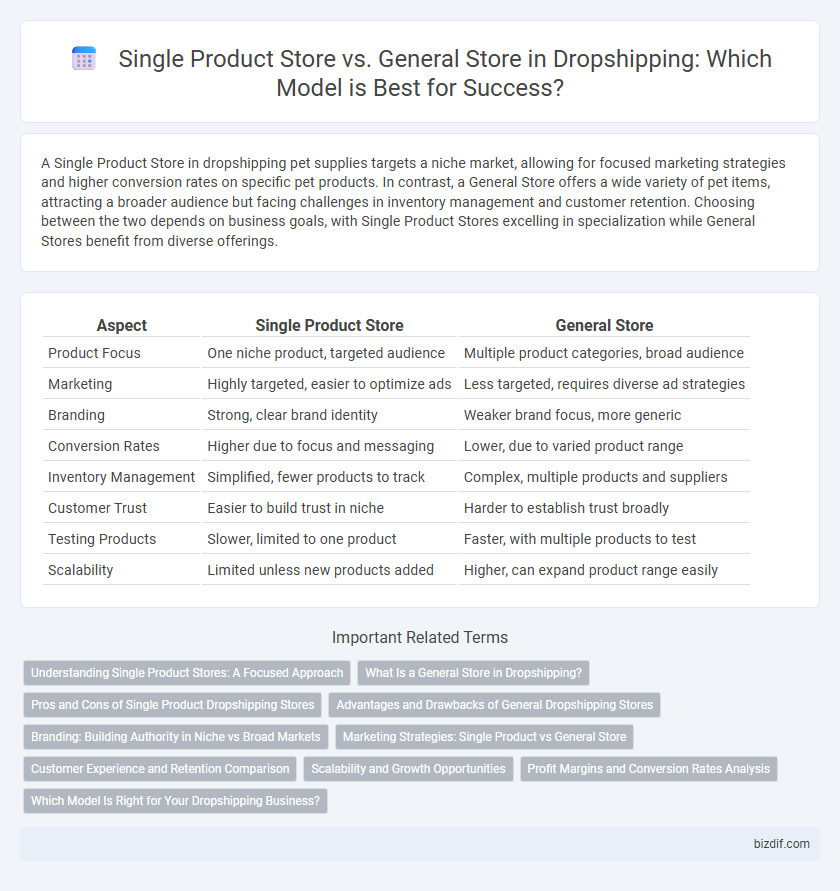A Single Product Store in dropshipping pet supplies targets a niche market, allowing for focused marketing strategies and higher conversion rates on specific pet products. In contrast, a General Store offers a wide variety of pet items, attracting a broader audience but facing challenges in inventory management and customer retention. Choosing between the two depends on business goals, with Single Product Stores excelling in specialization while General Stores benefit from diverse offerings.
Table of Comparison
| Aspect | Single Product Store | General Store |
|---|---|---|
| Product Focus | One niche product, targeted audience | Multiple product categories, broad audience |
| Marketing | Highly targeted, easier to optimize ads | Less targeted, requires diverse ad strategies |
| Branding | Strong, clear brand identity | Weaker brand focus, more generic |
| Conversion Rates | Higher due to focus and messaging | Lower, due to varied product range |
| Inventory Management | Simplified, fewer products to track | Complex, multiple products and suppliers |
| Customer Trust | Easier to build trust in niche | Harder to establish trust broadly |
| Testing Products | Slower, limited to one product | Faster, with multiple products to test |
| Scalability | Limited unless new products added | Higher, can expand product range easily |
Understanding Single Product Stores: A Focused Approach
Single product stores concentrate exclusively on one niche item, enabling targeted marketing and tailored customer experiences that boost conversion rates. This focused approach simplifies inventory management, reduces operational complexity, and enhances brand identity, making it easier to build trust and authority in a specific market segment. By honing in on a single product, dropshippers can optimize ad spend and improve product-specific customer support, driving higher profitability and scalability.
What Is a General Store in Dropshipping?
A general store in dropshipping offers a wide variety of products across multiple niches, aiming to attract a broad customer base and test different market demands simultaneously. This approach contrasts with single product stores by providing diverse inventory, which can reduce risk through variety but may require more extensive marketing strategies to manage and optimize. Effective general stores leverage analytics to identify bestsellers and adjust their product listings accordingly to maximize profitability.
Pros and Cons of Single Product Dropshipping Stores
Single product dropshipping stores offer focused marketing and streamlined inventory management, leading to higher conversion rates and easier brand building. However, they carry the risk of limited audience appeal and dependency on a single product's success, making them vulnerable to market fluctuations. Lower complexity and specialized customer targeting provide efficiency, but diversification challenges can hinder long-term growth.
Advantages and Drawbacks of General Dropshipping Stores
General dropshipping stores offer a diverse product range that attracts a broader customer base, increasing potential sales opportunities. However, the lack of niche focus can result in diluted branding and higher marketing costs due to less targeted advertising. Managing inventory and supplier relationships becomes more complex, potentially affecting customer experience and fulfillment speed.
Branding: Building Authority in Niche vs Broad Markets
Single product stores excel in branding by establishing authority within a specific niche, fostering customer trust and loyalty through targeted marketing and tailored product offerings. General stores cater to broad markets, offering a wide range of products but often struggle with brand identity and consistent messaging. Building niche authority through single product stores enhances customer engagement and long-term business sustainability in dropshipping.
Marketing Strategies: Single Product vs General Store
Single product stores concentrate their marketing strategy on targeted audiences through precise messaging and tailored ad creatives that highlight the unique benefits of one product, resulting in higher conversion rates and simplified customer journeys. General stores employ broad marketing strategies across multiple product categories, leveraging cross-selling and retargeting campaigns to maximize average order value and attract a diverse customer base. Data-driven ad optimization and niche audience segmentation are critical for single product stores, while general stores rely on extensive product variety and brand trust to sustain long-term customer engagement.
Customer Experience and Retention Comparison
Single Product Stores offer a streamlined, focused shopping experience that enhances customer satisfaction by reducing decision fatigue and enabling deeper product knowledge, which often leads to higher retention rates. In contrast, General Stores provide a wide variety of products appealing to diverse customer needs but may dilute brand identity and complicate customer loyalty efforts. Data indicates Single Product Stores achieve better repeat purchase rates due to targeted marketing and personalized engagement strategies.
Scalability and Growth Opportunities
Single product stores enable focused marketing and higher conversion rates by targeting a specific niche, but scalability can be limited due to dependence on one item's performance. General stores offer broader product range options, attracting diverse customer segments and enhancing growth opportunities through cross-selling and upselling. However, managing inventory complexity and marketing strategies across multiple categories requires more resources and sophisticated operational systems.
Profit Margins and Conversion Rates Analysis
Single product stores typically achieve higher profit margins due to focused marketing efforts and streamlined inventory management, which reduce overhead costs and increase customer trust. These stores also experience higher conversion rates as visitors encounter a clear, compelling product offer without the distraction of multiple options. Conversely, general stores may attract a broader audience but often face lower profit margins and conversion rates because of diversified product lines and diluted brand identity.
Which Model Is Right for Your Dropshipping Business?
Choosing between a Single Product Store and a General Store depends on your niche focus and marketing strategy. A Single Product Store allows for targeted branding and higher conversion rates by promoting one product deeply, while a General Store offers diverse product options and tests market demand across multiple categories. Entrepreneurs prioritizing streamlined inventory and focused customer engagement might prefer Single Product Stores, whereas those seeking broader market coverage and product variety may find General Stores more suitable.
Single Product Store vs General Store Infographic

 bizdif.com
bizdif.com